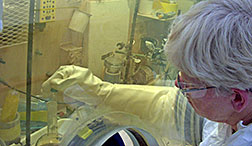- Number 413 |
- May 12, 2014
New sighting of superheavy element 117

ORNL's Rose Boll works on the production
of highly purified berkelium-249, which is
used as a target material in the synthesis
of element 117.
Aided by a supply of the extremely rare element berkelium produced at DOE’s Oak Ridge National Laboratory, an international research collaboration has presented new evidence of element 117. The study, published in Physical Review Letters, strengthens the case for the discovery of the superheavy element first observed in 2010 by a Russian-U.S. team.
Superheavy elements, or those beyond the atomic number 104 in the periodic table, are produced in a laboratory by accelerating beams of nuclei toward a heavy target material. Fusion of the two nuclei can occasionally yield new, short-lived superheavy elements.
The latest experiment required close coordination between the accelerator and detection capabilities at GSI Helmholtz Centre for Heavy Ion Research in Darmstadt, Germany, and ORNL’s unique actinide isotope production and separation facilities. The special berkelium target material, essential to the synthesis of element 117, was produced over an 18-month-long campaign, including intense neutron irradiation at ORNL’s High Flux Isotope Reactor and chemical separation and purification at the lab’s Radiochemical Engineering Development Center.
[Morgan McCorkle, 865.574.7308,
mccorkleml@ornl.gov]
